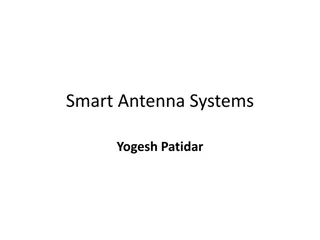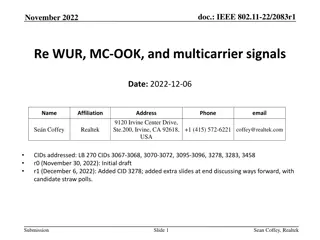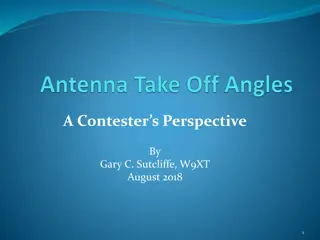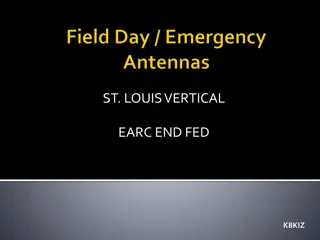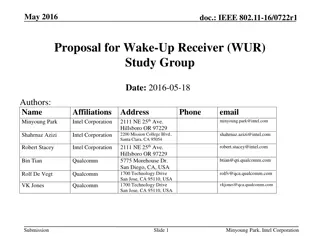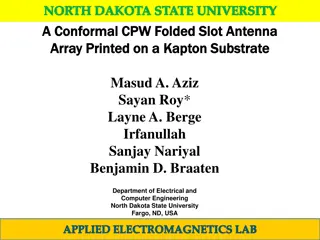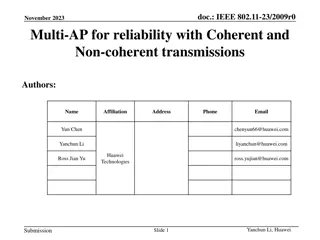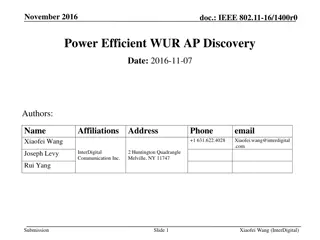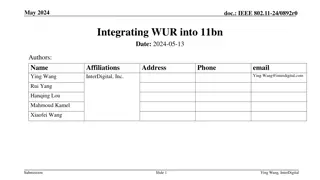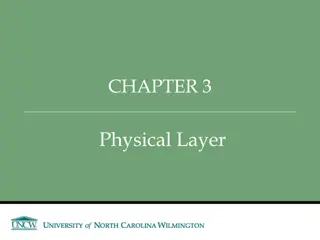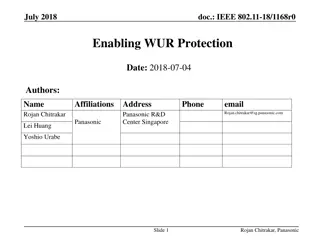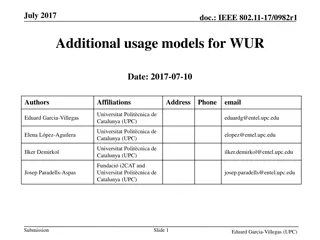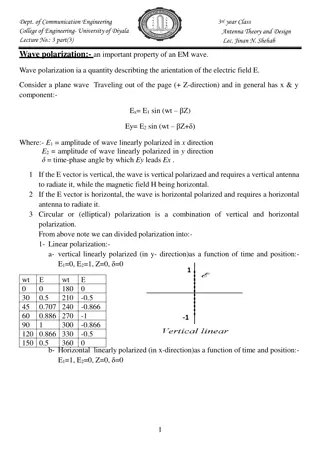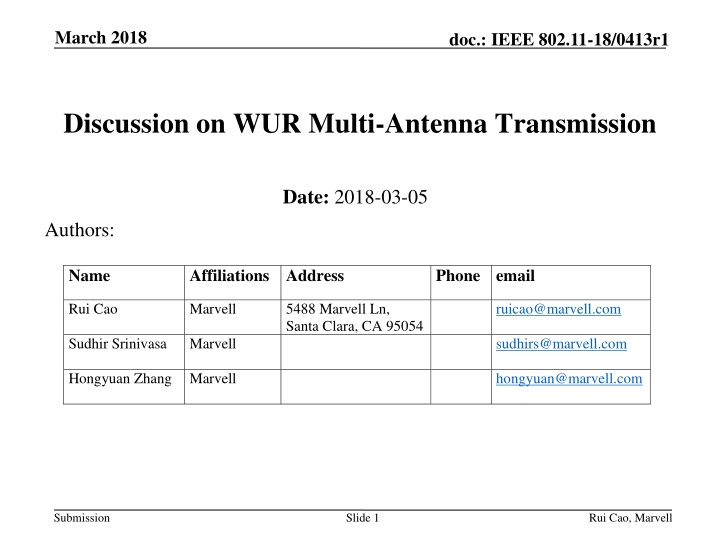
WUR Multi-Antenna Transmission Discussion in IEEE 802.11-18/0413r1
Explore the necessity and feasibility of cyclic shift diversity (CSD) for Wake-Up Radio (WUR) in multi-antenna transmissions, along with simulations on WUR performance using different CSD values. The discussion covers the use of CSD in WUR transmitters equipped with multiple antennas, including spatial mapping techniques and implications for legacy and WUR portions. Additionally, the potential benefits of CSD in spatial mapping for WUR transmissions are highlighted.
Download Presentation

Please find below an Image/Link to download the presentation.
The content on the website is provided AS IS for your information and personal use only. It may not be sold, licensed, or shared on other websites without obtaining consent from the author. If you encounter any issues during the download, it is possible that the publisher has removed the file from their server.
You are allowed to download the files provided on this website for personal or commercial use, subject to the condition that they are used lawfully. All files are the property of their respective owners.
The content on the website is provided AS IS for your information and personal use only. It may not be sold, licensed, or shared on other websites without obtaining consent from the author.
E N D
Presentation Transcript
March 2018 doc.: IEEE 802.11-18/0413r1 Discussion on WUR Multi-Antenna Transmission Date: 2018-03-05 Authors: Name Affiliations Address Phone email Rui Cao Marvell 5488 Marvell Ln, Santa Clara, CA 95054 ruicao@marvell.com Sudhir Srinivasa Marvell sudhirs@marvell.com hongyuan@marvell.com Hongyuan Zhang Marvell Submission Slide 1 Rui Cao, Marvell
March 2018 doc.: IEEE 802.11-18/0413r1 Introduction WUR transmitter likely shares the same radio with main WiFi radio using multiple-antennas. In WiFi main radio, cyclic shift diversity (CSD) technique is adopted to avoid unintentional spatial nulling In this contribution, we discuss the necessity and feasibility of CSD for WUR, and simulate the WUR performance with different CSD values Submission Slide 2 Rui Cao, Marvell
March 2018 doc.: IEEE 802.11-18/0413r1 Review: 11n/ac/ax CSD VHT SIGA VHT STF LTF SIGB DATA LLTF LSIG LSTF Pre-VHT Portion VHT Portion From 802.11n, cyclic shift diversity (CSD) is defined for MIMO systems to avoid unintentional destructive beamforming In Pre-HT/VHT/HE portion of the packet, CSD is defined per antenna as the spatial mapping technique. In HT/VHT/HE portion, CSD is defined per-stream. Spatial mapping is up to the transmitter s design. Beamforming can be applied to get the spatial mapping/steering matrix. Submission Slide 3 Rui Cao, Marvell
March 2018 doc.: IEEE 802.11-18/0413r1 WUR Multi-Antenna Transmission BPSK Mark WUR Data LLTF LSIG WUR SYNC LSTF Legacy WUR WUR packet is single-stream : both Legacy portion and WUR portion. For a WUR transmitter equipped with multiple antennas, if similar CSD design as 802.11n/ac/ax is adopted Legacy portion uses the same spatial CSD values as 802.11n/ac/ax. This is important for other main radios to correctly set CCA. WUR portion will not need per-steam CSD. WUR transmitter can determine its spatial mapping matrix based on instantaneous or statistical channel information. Submission Slide 4 Rui Cao, Marvell
March 2018 doc.: IEEE 802.11-18/0413r1 WUR Spatial Mapping WUR transmitter equipped with multiple antennas may perform beamforming on WUR portion. WUR does not define explicit sounding protocol Some implicit channel information may be obtained from main radio. If beamforming is not available at a WUR transmitter, other spatial mapping techniques can be applied, for example, CSD can be a good spatial mapping candidate. Random phase rotation across antennas For broadcast/multicast wake-up, CSD will also be effective. Submission Slide 5 Rui Cao, Marvell
March 2018 doc.: IEEE 802.11-18/0413r1 CSD for WUR 11n/ac/ax CSD is designed according to minimum 20MHz signal bandwidth [1] The minimum shift is 50ns (<=4Tx) or 25ns(<=8Tx) The maximum shift is 200ns WUR signal bandwidth is 4MHz The resolvable channel delay is 250ns. With 11n/ac/ax per-antenna CSD, shifted delay taps from all Tx antennas are not resolvable. Larger CSD values create better diversity, but the longer delay spread will cause more CS/timing inaccuracy for WUR. Simple WUR CSD design: reuse 11n/ac/ax per-antenna CSD table [1], and WUR portion applies N times of 11n/ac/ax CSD values. Submission Slide 6 Rui Cao, Marvell
March 2018 doc.: IEEE 802.11-18/0413r1 Simulation Settings WUR Packet WUR Data signal uses center 13 tones in 20MHz bandwidth Payload: 48 bits, Manchester Coding 2ms noise appended before the WUR packet BPSK Mark 2ms noise WUR Data LLTF LSIG WUR SYNC LSTF SNR defined on 20MHz noise CFO = 20ppm, fc = 2.4GHz, No phase noise Receiver Realistic AGC: entire packet is normalized to certain gain target Noise portion normalized based on the noise power WUR portion normalized by 20MHz preamble power 3th order 4MHz butterworth filter with 2.5MHz cutoff frequency 4MHz sampling rate with in-phase path Submission Slide 7 Rui Cao, Marvell
March 2018 doc.: IEEE 802.11-18/0413r1 D-NLOS 2x1 WUR,2x1, DNLos, LDR WUR,2x1, DNLos, HDR 0 0 10 10 no CSD 11ac CSD random phase 11ac CSD+random phase -1 -1 10 10 PER PER -2 -2 no CSD 11ac CSD random phase 11ac CSD+random phase 10 10 -3 -3 10 10 -10 -5 0 5 10 15 -5 0 5 10 15 SNR(dB) SNR(dB) 11ac CSD show performance improvement for LDR, but degradation for HDR Random phase helps Submission Slide 8 Rui Cao, Marvell
March 2018 doc.: IEEE 802.11-18/0413r1 D-NLOS 4x1 WUR,4x1, DNLos, LDR WUR,4x1, DNLos, HDR 0 0 10 10 -1 10 -1 PER PER 10 -2 10 no CSD 11ac CSD random phase 11ac CSD+random phase no CSD 11ac CSD random phase 11ac CSD+random phase -3 -2 10 10 -5 0 5 10 15 -6 -4 -2 0 2 4 6 8 10 12 14 16 SNR(dB) SNR(dB) 11ac CSD show performance improvement for LDR, but degradation for HDR Random phase helps Submission Slide 9 Rui Cao, Marvell
March 2018 doc.: IEEE 802.11-18/0413r1 B-LOS 2x1 WUR,2x1, B-LOS, LDR WUR,2x1, B-LOS, HDR 0 0 10 10 -1 -1 10 10 PER PER -2 -2 10 10 no CSD 11ac CSD random phase 11ac CSD+random phase no CSD 11ac CSD random phase 11ac CSD+random phase -3 -3 10 10 -10 -5 0 5 10 15 -5 0 5 10 15 SNR(dB) SNR(dB) 11ac CSD show good performance improvement Random phase also helps Submission Slide 10 Rui Cao, Marvell
March 2018 doc.: IEEE 802.11-18/0413r1 B-LOS 4x1 WUR,4x1, B-LOS, HDR WUR,4x1, B-LOS, LDR 0 0 10 10 -1 10 -1 PER PER 10 no CSD 11ac CSD random phase 11ac CSD+random phase -2 10 no CSD 11ac CSD random phase 11ac CSD+random phase -2 -3 10 10 -6 -4 -2 0 2 4 6 8 10 12 14 16 -10 -5 0 5 10 15 SNR(dB) SNR(dB) 11ac CSD show performance degradation, >1dB for HDR Random phase helps Submission Slide 11 Rui Cao, Marvell
March 2018 doc.: IEEE 802.11-18/0413r1 D-NLOS 2x1 WUR,2x1, DNLos, LDR WUR,2x1, DNLos, HDR 0 0 10 10 -1 -1 10 10 PER PER 1x1 no CSD 1x11ac CSD 2x11ac CSD 3x11ac CSD 4x11ac CSD 5x11ac CSD 1x1 no CSD 1x11ac CSD 2x11ac CSD 3x11ac CSD 4x11ac CSD 5x11ac CSD -2 -2 10 10 -3 -3 10 10 -10 -5 0 5 10 15 -5 0 5 10 15 SNR(dB) SNR(dB) Larger CSD improves sensitivity significantly Performance gets close to 1Tx performance Submission Slide 12 Rui Cao, Marvell
March 2018 doc.: IEEE 802.11-18/0413r1 D-NLOS 4x1 WUR,4x1, DNLos, LDR WUR,4x1, DNLos, HDR 0 0 10 10 -1 -1 10 10 PER PER 1x1 no CSD 1x11ac CSD 2x11ac CSD 3x11ac CSD 4x11ac CSD 5x11ac CSD 1x1 no CSD 1x11ac CSD 2x11ac CSD 3x11ac CSD 4x11ac CSD 5x11ac CSD -2 -2 10 10 -3 -3 10 10 -10 -5 0 5 10 15 -5 0 5 10 15 SNR(dB) SNR(dB) Larger CSD improves sensitivity significantly Performance gets close to 1Tx performance Submission Slide 13 Rui Cao, Marvell
March 2018 doc.: IEEE 802.11-18/0413r1 B-LOS 2x1 WUR,2x1, B-LOS, LDR WUR,2x1, B-LOS, HDR 0 0 10 10 -1 -1 10 10 PER PER 1x1 no CSD 1x11ac CSD 2x11ac CSD 3x11ac CSD 4x11ac CSD 5x11ac CSD 1x1 no CSD 1x11ac CSD 2x11ac CSD 3x11ac CSD 4x11ac CSD 5x11ac CSD -2 -2 10 10 -3 -3 10 10 -10 -5 0 5 10 15 -5 0 5 10 15 SNR(dB) SNR(dB) Larger CSD improves sensitivity significantly Performance gets close to 1Tx performance Submission Slide 14 Rui Cao, Marvell
March 2018 doc.: IEEE 802.11-18/0413r1 B-LOS 4x1 WUR,4x1, B-LOS, HDR WUR,4x1, B-LOS, LDR 0 0 10 10 -1 -1 10 10 PER PER 1x1 no CSD 1x11ac CSD 2x11ac CSD 3x11ac CSD 4x11ac CSD 5x11ac CSD 1x1 no CSD 1x11ac CSD 2x11ac CSD 3x11ac CSD 4x11ac CSD 5x11ac CSD -2 -2 10 10 -3 -3 10 10 -5 0 5 10 15 -10 -5 0 5 10 15 SNR(dB) SNR(dB) Larger CSD improves sensitivity significantly Performance gets close to 1Tx performance Submission Slide 15 Rui Cao, Marvell
March 2018 doc.: IEEE 802.11-18/0413r1 Discussion It is important to inherit the CSD design on the Legacy portion for CCA. Spatial mapping in WUR portion Beamforming is preferable if channel is known from PCR. CSD can be a good candidate when beamforming is not available. 11n/ac/ax CSD table is not effective for WUR portion to achieve spatial diversity. Performance degradation is observed for some cases. Evaluate larger CSD values using N times of 11n/ac/ax CSD values Some diversity gain is achieved at sensitivity point In some configuration/channel, high error floor is also observed Prefer to let the transmitter to decide the spatial mapping techniques, like in 11n/ac/ax. Submission Slide 16 Rui Cao, Marvell
March 2018 doc.: IEEE 802.11-18/0413r1 Straw Poll 1 Do you agree that the Legacy portion of an 11ba multi- antenna transmission uses spatial mapping with the same pre-VHT CSD table in [1]? Y: N: A: Submission Slide 17 Rui Cao, Marvell
March 2018 doc.: IEEE 802.11-18/0413r1 Straw Poll 2 Do you agree that 11ba multi-antenna transmission does NOT mandate the spatial mapping technique for the WUR portion? Y: N: A: Submission Slide 18 Rui Cao, Marvell
March 2018 doc.: IEEE 802.11-18/0413r1 Reference [1] Table 21.10, IEEE P802.11-REVmc/D8.0 Submission Slide 19 Rui Cao, Marvell


